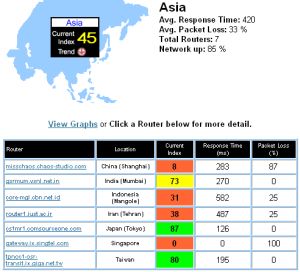Taiwan quake continues to cripple Asian businesses

update SINGAPORE--Internet connections across Asia remain congested after Tuesday's earthquake off Taiwan's southern coastline damaged several major submarine cables connecting Asia and the United States.
Measuring 7.1 on the Richter scale, the natural disaster crippled business communications across the region yesterday bringing Internet connection to an agonizing crawl. Countries including Japan, China, South Korea and Malaysia, were affected.
According to Benjamin Tan, managing director of Singapore-based ISP SuperInternet, seven of eight major submarine (or undersea) cable systems that run between Asia, Europe and the United States were damaged by the quake. SMW4 was the only cable system left unaffected. Some of the seven affected cable systems--which include Flag Telecom, East Asia Crossing (EAC) and Asia-Pacific Cable Network (APCN)--have since had some partial restoration.
Tan noted that Tuesday's catastrophe underscored the need for service providers to adopt a "carrier-agnostic" strategy so they can continue to provide Internet access services.
He added that SuperInternet spreads its bandwidth capacity across multiple providers which run on just about all of the eight major cable lines, so the local ISP can regain Internet connection from any of the other links if one goes down.
"We have close to 10 different outbound links, which incidentally costs us more than buying the same amount of aggregated traffic from just one or two carriers," Tan said. "But it has given us a better bandwidth [architecture]."
This strategy has allowed the company to remain relatively unscathed from the paralyzing effects of Tuesday's quake. SuperInternet has about 2,000 customers across government and enterprise industry segments, and home users.
"We're better off than the bigger providers who claim that they own their own cables," Tan said. "If you own your own cables, then you don't diversify to other carriers' cables. So when your cables go down, you have no way out."
Alex Tan, director of local ISP Qala, agreed that adopting a multi-carrier strategy was his company's saving grace amid this week's network disruption. However, it is not necessarily risk-free.
Qala's Tan said: "It's also a matter of hedging your bets on the right [mix] of suppliers. With an impact as widespread as this week's events, where so many cables were damaged, the risk is still quite high that [the various carriers you've bought bandwidth from] may have all been affected."
Qala has some 6,000 corporate customers ranging from SMBs (small and midsize businesses) to major MNCs (multinational corporations). Like SuperInternet, Qala buys bandwidth from multiple carriers and was able to move its traffic to a supplier that was unaffected by the damaged cables.
However, Internet connection remains slow due to congestion since most traffic has been moved to the same working network pipe--the SMW4, he said.
Tan added that Qala's smaller SMB customers that relied mostly on local traffic were largely unaffected.
 Source: Internet Traffic Report |
At press time, the Internet Traffic Report showed that Asia's average Internet packet loss clocked at 33 percent, where SingTel's IX gateway, for instance, had flatlined with a 100 percent data packet loss. The Internet Traffic Report monitors data flow around the world, taking a sampling of data transfer from routers across the globe.
According to SuperInternet's Tan, under good network conditions, the average data packet loss is typically below 1 percent.
Qala's Tan said: "The entire highway is congested because everyone is pushing their customers to the same pipe, and I'm sure the other alternative routes are also getting congested."
He said this is likely to go on for at least another week as carriers have indicated that it could take 10 working days to repair the damaged cables.
SuperInternet's Tan noted that when an EAC undersea cable broke in June 2005, restoration works lasted two weeks. "And that was for one single cable... I'm not sure if there'll be sufficient repair boats ready to sail out [concurrently] to fix the seven damaged cables," he said.
A spokesperson from local carrier and ISP, StarHub, issued an update this evening, noting that 80 percent of its Internet bandwidth has been "successfully diverted" to other undersea cables. "Our engineers will continue to do their best to rectify the matter as soon as possible," he told ZDNet Asia.
A SingTel spokesperson said the local carrier has set up a command center "to monitor and manage the situation". He added that several services remain affected, including disruptions to its BlackBerry service and private data network services of some of SingTel's corporate customers. According to SingTel, all voice traffic to Taiwan has been restored though there may be some congestion.
"We continue to work closely with other submarine cable consortium members to restore and repair the damaged cables as soon as possible," he said. According to the operator, all voice traffic to Taiwan has been restored though there may be some congestion.
Singapore's telecom regulator, Infocomm Development Authority (IDA), said it is also monitoring "the current regional situation".
"The [damaged] cable systems are being restored progressively, although full restoration may take as long as a few weeks," said an IDA spokesperson. "Singapore, being a telecom hub, strives to ensure that communication links are always on through diverse offerings, such as alternative submarine cable systems and communications systems such as satellites."